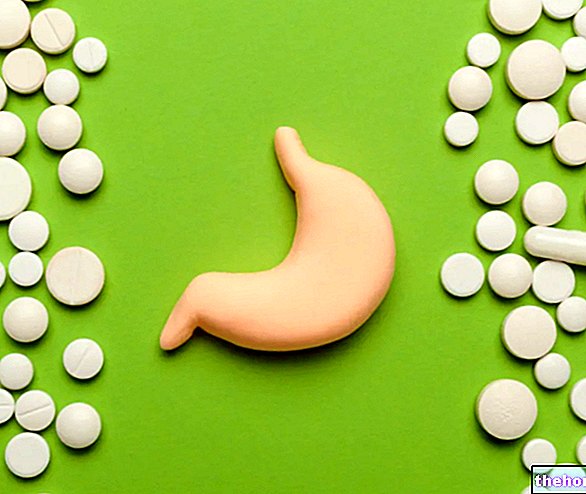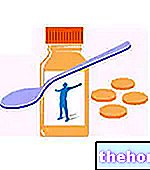Definition
Pulmonary hypertension - also called idiopathic pulmonary arterial hypertension - it is a rather rare disorder that manifests itself with a pathological increase prolonged blood pressure in the lungs and right side of the heart ONLY, in the absence of an identifiable cause. Pulmonary hypertension is a serious disease whose symptomatological picture often tends to degenerate progressively and rapidly.
Causes
In the context of pulmonary hypertension, blood cannot flow normally in the lungs, due to a narrowing or occlusion of the pulmonary arteries and capillaries: pulmonary hypertension affects the heart which, forced to overwork, "weakens.
- Hypothetical risk factors: obstructive sleep apnea, long-term low blood oxygen levels, COPD, pulmonary embolism, HIV infections, congestive heart failure, pulmonary fibrosis, some heart valve diseases, rheumatic diseases.
Symptoms
Shortness of breath and lightheadedness during sports are the first signs that should alert a patient suffering from pulmonary hypertension. Other recurrent symptoms associated with this rare disease include: swollen ankles, cyanosis, weakness, chest pain, fatigue, fainting, tachycardia, dizziness.
Information on Pulmonary Hypertension - Medicines for the Treatment of Pulmonary Hypertension is not intended to replace the direct relationship between the health professional and the patient. Pulmonary hypertension.
Medicines
Before starting to analyze the drugs and possible treatments to alleviate the symptoms of pulmonary hypertension, we schematically report the mechanism that triggers the disorder, which will help to better understand the choice of therapeutic strategies.
Narrowing of the pulmonary arteries → blood struggles to flow into the lungs → ↑ pressure → the right ventricle is forced to over-strain to pump blood into the lungs → enlarged ventricle → weakening of the heart and heart failure
Although a completely resolutive cure for pulmonary hypertension has not yet been identified, current treatment options aim to alleviate symptoms, improve the patient's quality of life and, above all, block or otherwise slow the inexorable progression of the disease.
It is first of all essential to intervene on the factors that predispose or accentuate pulmonary hypertension, such as (in particular) apneas, lung diseases and heart valve disorders.
The doctor will choose which drug is most suitable for the patient, according to the triggering cause (hypothesized or ascertained, when identifiable) and the evident symptoms; some patients need to take blood thinners to reduce the risk of blood clots forming in the veins of the lower limbs or in the pulmonary arteries.
In many pulmonary hypertension patients, low levels of oxygen in the blood are observed: in these cases, it is necessary to intervene promptly with appropriate therapy (oxygen supplementation).
Patients with pulmonary hypertension should quit smoking, avoid traveling to high altitude locations, abstain from heavy physical activity and lifting, and undergo annual influenza and pneumococcal vaccines.
In cases of severity, transplantation of heart, lung, or both is conceivable.
The following are the classes of drugs most used in the therapy against pulmonary hypertension, and some examples of pharmacological specialties; it is up to the doctor to choose the active ingredient and the dosage most suitable for the patient, based on the severity of the disease, the state health of the patient and his response to treatment:
First-line drugs for the treatment of pulmonary hypertension:
- Ambrisentan (Eg Volibris): the drug belongs to the class of endothelin receptor inhibitors; the active ingredient excellently exerts its therapeutic activity in the context of pulmonary hypertension by blocking the receptors of the hormone endothelin, responsible for constricting the vessels By destroying hormone activity, ambrisentan dilates blood vessels and promotes a reduction in altered pulmonary pressure. The recommended dose suggests taking 5 mg of the drug orally, once a day, with food or on an empty stomach.
- Bosentan (eg. Tracleer): the drug, like the previous one, is an inhibitor of endothelin-1. For adults weighing more than 40 kg, suffering from pulmonary hypertension, it is recommended to start taking the drug at a dose of 62 , 5 mg, twice a day, for one month. The maintenance posology involves increasing the dose up to 125 mg, twice a day. For affected subjects who weigh less than 40 kg, it is recommended to maintain the dose of 62.5 mg, both for initiation and maintenance treatment The drug can induce liver toxicity.
- Iloprost (Eg ventavis): available in the form of a nebulizer, the drug is a prostacyclin analogue capable of dilating blood vessels, thus reducing blood pressure and improving symptoms derived from pulmonary hypertension. It is recommended to start therapy by inhaling the drug with an inhaler at a dose of 2.5 micrograms; follow therapy with doses of 5 micrograms. In case the dose of 5 micrograms is too strong for the patient, it is advisable to return to the initial dose and continue the therapy according to this therapeutic scheme It is recommended not to administer more than 6-9 sprays per day.
- Sitacentan sodium (eg Thelin): the drug belongs to the class of endothelin-1 inhibitors. It is recommended to take one 100 mg tablet, once a day, with or without food. It is recommended to take the drug approximately always at same time. In case of treatment failure after 3 months of treatment, it is advisable to change the drug. The drug was suspended in 2011 due to severe hepatic side effects.
- Sildenafil (eg Revatio): the drug is widely used in therapy for the treatment of erectile dysfunction; however, being a 5-phosphodiesterase inhibitor, it is also used to reduce the symptoms of pulmonary hypertension since, by modulating the effect of nitric acid on vascular tone, it is a good, relatively selective vasodilator of the pulmonary arteries. take the drug at a dose of 20 mg, orally, three times a day, at least 4-6 hours apart between one dose and the next. Alternatively, it is possible to take 10 mg (equivalent to 12.5 ml) by intravenous bolus injection, three times a day: the posology described above determines the same therapeutic effect as an oral dose of 20 mg. Generally, this second indication is reserved for patients previously treated with oral Sildenafil and temporarily unable to take the drug by mouth.
- Nitric oxide (eg INOmax): drug to be inhaled, indicated for the treatment of neonatal pulmonary hypertension, especially when associated with hypoxic respiratory insufficiency. In general, the drug is not used alone, but with other specific drugs; moreover, the patient is normally also subjected to assisted ventilation, in order to improve oxygenation. The active ingredient is diluted in nitrogen gas at a concentration of 400 ppm. For the precise dosage: consult your doctor.
- Tadalafil (eg Adcirca): the drug belongs to the class of type 5 phosphodiesterase inhibitors, capable, therefore, of blocking the enzyme. It is recommended to take the drug at a dose of one 40 mg tablet, twice a day Reduce the dosage in case of mild or moderate renal or hepatic deficiency, however, therapy with this drug is not recommended in case of severe kidney or liver deficiency.
Parallel therapies for the control of pulmonary hypertension symptoms
Some specialists also recommend taking standard drugs used in therapy for the treatment of hypertension; calcium channel blockers (or calcium channel blockers) and diuretics seem to be particularly suitable.
Anticoagulant therapy to prevent the complications of pulmonary hypertension
- Isosorbide dinitrate (eg. Carvasin, Dinike, Nitrosorbide): the drug is a nitrate, also used for the treatment of angina pectoris; it is used as a second choice for the treatment of symptoms related to pulmonary hypertension. Begin therapy with a drug dose of 40 mg, every 8-12 hours. Continue with maintenance therapy at a dose of 40-80 mg, every 8-12 hours.
- Epoprostenol (eg. Flolan, Epoprostenol PHT): promotes vasodilation and inhibits platelet aggregation. For this reason, the drug is used in therapy for the control of pulmonary hypertension symptoms. Start therapy with a drug dose equal to 2 ng / kg / min; gradually increase the dose in increments of 2 ng / kg every 15 minutes Do not exceed 8.6 ng / kg / min Consult your doctor for more information.
Hypotheses and hopes for the treatment of pulmonary hypertension
Scientists are directing their research for the treatment of pulmonary hypertension towards testing new drugs, such as serotonin antagonists, soluble guanylate cyclase stimulants, tyrosine kinase inhibitors and vasoactive intestinal peptide. years before finding the truly miraculous drug - therefore completely decisive - for pulmonary hypertension.



























